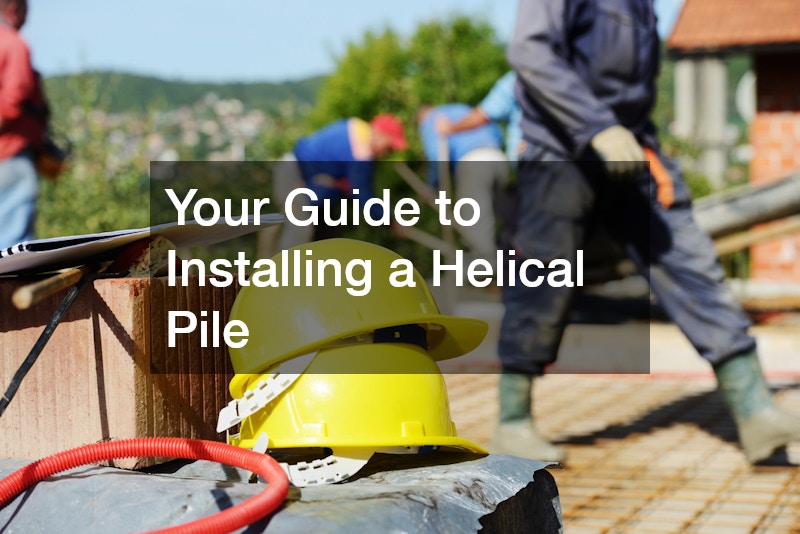This article provides a comprehensive guide to installing a helical pile, a solution popular in construction for its efficiency and adaptability. Whether you’re a homeowner looking to enhance your property’s stability or a professional in the building industry, understanding the intricacies of helical piles, from installation to maintenance, is crucial. This guide aims to answer the most common questions and provide detailed steps on the installation process.
Understanding the Purpose of a Helical Pile
Helical piles are a type of deep foundation system used to support structures in a variety of soil conditions. They consist of a central steel shaft with helix-shaped plates welded to it.
The helical plates function as both the bearing surface and an auger, allowing the pile to be screwed into the soil. The design and size of these plates depend on the load requirements and soil conditions at the site.
Helical piles are versatile and can be installed in restricted spaces with minimal disturbance to the surrounding environment. Their design allows for immediate load-bearing capacity post-installation, facilitating efficient construction timelines.
Load transfer in helical piles occurs through both end-bearing on the soil below and side friction along the shaft. This combination ensures the structure’s stability by distributing loads effectively.
End-bearing force is critical when the pile reaches a dense stratum layer, while shaft friction offers additional support. These types of load transfers contribute to the piles’ ability to carry significant structural loads.
This flexibility in load management is why helical piles are preferred in areas where traditional foundations may require extensive modification. Therefore, understanding and calculating load transfer is essential for successful helical pile installation.
Following the Steps to Install a Helical Pile
The first stage in installing helical piles involves assessing the site conditions and preparing it for installation. This includes soil testing and layout planning to ensure the correct installation procedure.
Soil testing helps determine the load-bearing capacity and identifies any geological challenges that may affect the pile’s performance. Proper site preparation is crucial to avoid common installation errors and ensure the longevity of the piles.

Layout planning allows contractors to design the optimal configuration of piles to suit specific foundation needs. This step is integral to a smooth installation process and subsequent structural stability.
Once preparation is complete, helical piles are installed using specialized equipment. The equipment includes rotary hydraulic drives attached to standard excavators or handheld devices for smaller projects.
This machinery screws the piles into the ground, with monitoring systems ensuring the correct torque levels are achieved. Maintaining the appropriate torque is essential for ensuring the piles are driven to optimal depths and capacities.
The installation process is relatively quick, often completed within days, minimizing labor costs and construction delays. Such efficiency is one of the many reasons helical piles are favored for both small and large-scale construction projects.
Acknowledging the Benefits of Using Helical Piles
Helical piles provide numerous benefits, including reduced installation time and cost-effectiveness, especially in areas with challenging soil conditions. Their adaptability makes them suitable for a range of construction projects.
The piles are designed to perform well under various environmental conditions, which lessens the project’s overall carbon footprint. This is achieved by reducing the need for excavation, drilling, and concrete usage in traditional foundations.
Additionally, helical piles can be installed with little noise and vibration, making them an ideal foundation solution in populated or environmentally sensitive areas. This feature further supports the use of helical piles in modern construction methodologies.
This section addresses the long-term performance of helical piles, covering maintenance practices that ensure they remain effective and durable over time. Helical piles, composed of galvanized steel, are resistant to rust and corrosion.
Regular inspections are recommended to ensure the piles maintain their integrity and continue to support the structure effectively. Maintenance practices may include checking for unusual shifts in the structure that could indicate issues with the piles.
Because of their sturdy construction and precise engineering, helical piles offer long-term reliability and minimal maintenance needs. Their durability and practicality fortify their status as a leading choice for foundation solutions worldwide.
Avoiding Common Misstakes
Common errors during the installation of helical piles include incorrect pile sizing and improper insertion angles. These mistakes can compromise the pile’s load-bearing capacity.
Ensuring that the right specifications are followed and the angle of insertion is accurately maintained is vital for a successful foundation. Proper training and the use of advanced monitoring technologies can mitigate these errors.
Regular site assessments and amendments guided by real-time feedback can prevent missteps during installation. Addressing these issues promptly maintains the structural health and integrity of the pile system.
Helical piles are an innovative and efficient solution for foundation needs in diverse environments. By following the outlined steps and avoiding common pitfalls, you can ensure a successful installation.
Whether used for new construction or to stabilize existing structures, helical piles are a reliable choice. Armed with this guide, you’re now equipped to make informed decisions and execute installations with confidence.



